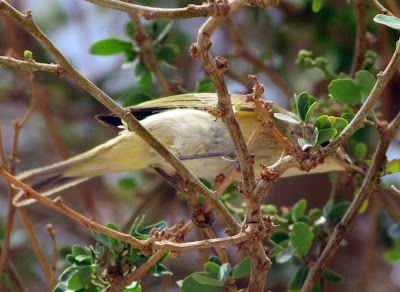a rainbow over Riyadh
It was an unusual day in the sense that it rained on and off. Riyadh only gets 95mm of rain in an average year but more than half of it usually falls in late March and early April. We have had light rain in about 5 days out of the last 14.
red-vented bulbul at al Waha
The two urban areas visited had a lot of communality in bird life. For example, both venues had the rare (for Saudi Arabia) red-vented bulbul alongside the extremely common white-cheeked bulbul.
chiffchaff at al Waha
Both venues had a selection of warblers and both sets were mostly found in the acacia trees and other natural vegetation. Ornamental trees were not fruitful for warblers.
There were chiffchaff at both places.
second chiffchaff at al Waha
However whereas we sighted also lesser whitethroat and common whitethroat at Al Waha, we saw an eastern olivaceous warbler at the Intercontinental. Eastern olivaceous warbler is the only mainstream warbler which commonly breeds in Riyadh's gardens and parks.
hoopoe at the Intercontinental
Hoopoe was also seen at both places. The one above was on the golf course.
common myna at the Intercontinental
Likewise common myna and laughing dove were also present at al Waha and the Intercontinental though we didn't see any collared dove at the hotel.
lake at the golf course
I can't recall seeing either red-tailed shrike in a residential compound all winter or spring. They are certainly rare there obviously preferring more natural settings. On the other hand, masked shrike and to a lesser extent woodchat shrike are disproportionately found in parks and gardens. Both birds will be flying on north.
masked shrike at the Intercontinental
The masked shrike appears to be a first cycle bird rather than say an adult female. It was confiding and allowed close contact.
woodchat shrike at the Intercontinental
The woodchat shrike was an adult male with a beautiful deep brown head. Incidentally there is still no sign of any red-backed shrike in the area.
rose ringed parakeet at the Intercontinental
There is a rule of thumb when it comes to rose-ringed parakeet. The larger gardens have them and the smaller ones don't. This rule held again. We only saw them at the Intercontinental.
yellow vented bulbul at the International
In general the larger Intercontinental had more species than al Waha too. We onyy observed yellow vented bulbul here.
pied wheatear on the fairway
Furthermore we only saw one wheatear all day and it was a pied wheatear on the fairway of the golf course at the Intercontinental.
Lou and I agreed that urban birding made a pleasant change. He compiled the list of birds seen below.
| Species | Place |
| Red-vented bulbul | Al Waha / Intercontinental |
| White cheeked bulbul | Al Waha / Intercontinental |
| Yellow-vented bulbul | Intercontinental |
| Collared dove | Al Waha / Intercontinental |
| Laughing dove | Al Waha / Intercontinental |
| Hoopoe | Al Waha / Intercontinental |
| Common myna | Al Waha / Intercontinental |
| Rose-ringed parakeet | Intercontinental |
| Rock pigeon | Al Waha / Intercontinental |
| Red-throated pipit | Intercontinental |
| Kestrel | Al Waha |
| Masked shrike | Intercontinental |
| Woodchat shrike | Intercontinental |
| Indian silverbill | Intercontinental |
| House sparrow | Al Waha / Intercontinental |
| Barn swallow | Al Waha |
| Common swift | Intercontinental |
| Black bush robin | Al Waha / Intercontinental |
| Common redstart | Intercontinental |
| Rufous bush robin | Intercontinental |
| Chiffchaff | Al Waha / Intercontinental |
| Common whitethroat | Al Waha |
| Eastern olivaceous warbler | Intercontinental |
| Lesser whitethroat | Al Waha |
| Pied wheatear | Intercontinental |













No comments:
Post a Comment